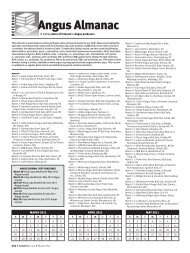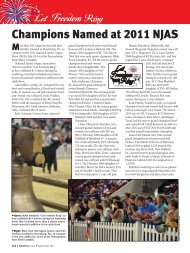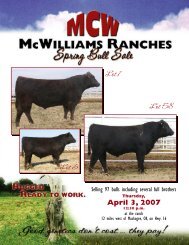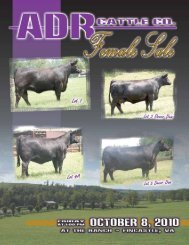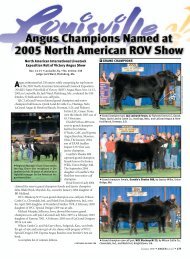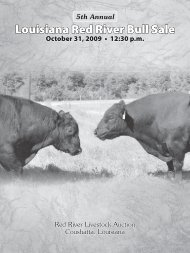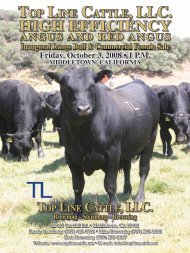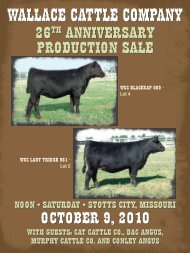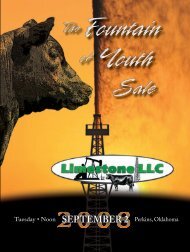Beef Genetic Management Guide - Angus Journal
Beef Genetic Management Guide - Angus Journal
Beef Genetic Management Guide - Angus Journal
You also want an ePaper? Increase the reach of your titles
YUMPU automatically turns print PDFs into web optimized ePapers that Google loves.
By: Al Kuck, Vice President, <strong>Beef</strong> Programs<br />
DNA marker technology has been advancing rapidly since the<br />
first markers were discovered in 1989. GeneSTAR ® was first<br />
introduced in 2000 as a single marker test for marbling. In 2004<br />
GeneSTAR<br />
Born:<br />
introduced three more marbling and<br />
Yrlg.<br />
three<br />
Frame:<br />
tenderness<br />
markers,<br />
Birth Weight:<br />
in 2006 four feed efficiency markers<br />
Mature<br />
were<br />
Frame:<br />
incorporated.<br />
Rankings<br />
205 Days:<br />
were expressed as stars which indicated<br />
Scrotal:<br />
the presence<br />
or absence 365 Days: of the desirable gene. In this <strong>Beef</strong> <strong>Genetic</strong> Tattoo: <strong>Management</strong><br />
<strong>Guide</strong> Mature: you will find Molecular Value Predictions Calving Ease (MVPs) Rating: listed<br />
under Owned each By: bull. It is the next logical iteration of genetic marker<br />
These Molecular Value Predictions are a significant improvement<br />
over the star system previously used by GeneSTAR. It is a more<br />
powerful tool because it provides direct information on the expectations<br />
when using a sire. It will be most valuable on animals that do not<br />
have a progeny proof or with relatively little progeny performance<br />
data. In our listings within the <strong>Beef</strong> <strong>Genetic</strong> <strong>Management</strong> <strong>Guide</strong>,<br />
we are also providing “percentile rankings” which indicate how the<br />
animal ranks within the respective breed. As an example, an animal<br />
in the 10th percentile would be better than 90% of the breed.<br />
selection. These predictions for feed efficiency, marbling and<br />
tenderness include the original 11 validated markers plus an<br />
additional 45 markers.<br />
The development of GeneSTAR MVPs followed a four step process:<br />
1. Discovery - identify panels of markers that are significantly<br />
correlated with one or more cattle groups with data for<br />
commercially important traits.<br />
2. Statistical methods - incorporate individual markers into<br />
larger marker panels to develop the MVP values.<br />
3. Evaluation - each marker panel is evaluated in separate<br />
cattle groups to see if it predicts the trait as well as it does<br />
in the original discovery population.<br />
4. Third Party Validation - the National <strong>Beef</strong> Cattle Evaluation<br />
Consortium acts as a third-party agency to validate DNA<br />
marker technology<br />
Trait Definition Units<br />
Feed<br />
Efficiency2<br />
Marbling3<br />
Feed Efficiency Marbling Tenderness<br />
1.03 -0.2 -0.38<br />
100% 100% 30%<br />
Difference between an<br />
animal’s actual and expected<br />
feed intake based on its body<br />
weight and growth rate<br />
Degree of intramuscular<br />
fatness in the longissimus<br />
dorsi (ribeye) muscle<br />
lbs./day<br />
Marbling<br />
Score 0 – 9<br />
MVP<br />
Range*<br />
Min: -3.17<br />
Max: 2.38<br />
Min: -1.00<br />
Max: 1.11<br />
While these new GeneSTAR MPVs are a much more useful tool,<br />
it is only the beginning of much bigger programs to come from<br />
Pfizer Animal <strong>Genetic</strong>s. Cattle producers will have access to a new<br />
suite of traits in 2010. This will come with the first commercial<br />
genomic predictions based on the high density BovineSNP50 chip.<br />
This chip will look at 50,000 individual SNP markers scattered<br />
throughout the cattle genome to predict a wide variety of traits.<br />
This very large panel of markers will yield much higher levels of<br />
accuracy of prediction. Validation studies are now underway<br />
and we would expect to have the test available in early 2010.<br />
The information will continue to be delivered using the MVP<br />
platform. Some of these will enhance the reliability of traditional<br />
EPD traits that we are all familiar with. Other MPVs will be<br />
for traits that are expensive and difficult to measure, and<br />
likely beyond the scope of most breeders to measure, yet are<br />
economically important.<br />
Average %<br />
Reliability<br />
30%<br />
26%<br />
We believe this new technology will be useful<br />
for producers in both the commercial and<br />
seedstock arenas. The commercial producer can<br />
identify his top production cows, and they can be<br />
bred with female-sorted semen to provide future<br />
replacements. The remainder can be bred to malesorted<br />
semen to provide a higher percentage of<br />
steers, taking advantage of the price differential.<br />
The seedstock producer can put top ranking animals<br />
into flushing programs, or breed top cows to male<br />
or female-sorted semen, depending on the needs<br />
of his customers. The remainder can be utilized as<br />
recipients or bred to a male-sorted terminal sire.<br />
Tenderness<br />
Force required to shear a<br />
cooked steak after<br />
postmortem aging<br />
W-B Shear<br />
Force (lbs.)<br />
Min: -1.04<br />
Max: 1.89<br />
* The closer the MVP value is to the highlighted Minimum or Maximum in each row,<br />
the more favorable the result. The reliability value is expressed a a percentage of<br />
the maximum accuracy available.<br />
49%<br />
The potential for management of rapid genetic progress<br />
will be unlike anything we have seen before! Watch<br />
for announcements on availability of this testing.<br />
Contact your Genex representative or Genex<br />
customer service (888-333-1783) for a test kit.<br />
60




